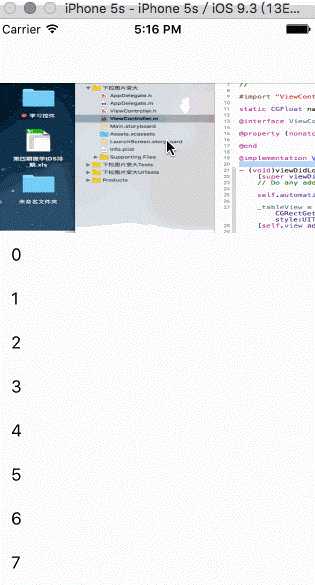标签:
效果图

开始简单的代码过程
其实思路很简单 就是 让tableView偏移 一图片的高度,然后在把图片添加到tableView中,然后再监听didScrollView,在里面改变图片的frame
- (void)viewDidLoad {
[super viewDidLoad];
// Do any additional setup after loading the view, typically from a nib.
self.automaticallyAdjustsScrollViewInsets = NO;
_tableView = [[UITableView alloc]initWithFrame:CGRectMake(0, navH, CGRectGetWidth(self.view.frame), CGRectGetHeight(self.view.frame) - navH) style:UITableViewStylePlain];
_tableView.delegate = self;
_tableView.dataSource = self;
/* 设置tableView的偏移量 **/
_tableView.contentInset = UIEdgeInsetsMake(startImageViewH, 0, 0, 0);
[self.view addSubview:_tableView];
/*
* 注意 imageView 的Y 值是-startImageViewH 其实这个值就是 tableView的内容偏移量
* 如果Y 是0的话它还是会跟着tableView偏移startImageViewH 值
**/
UIImageView * imageView = [[UIImageView alloc]initWithFrame:CGRectMake(0, -startImageViewH, CGRectGetWidth(self.view.frame), startImageViewH)];
imageView.image = [UIImage imageNamed:@"1"];
self.imageView = imageView;
[self.tableView addSubview:imageView];
}
- (void)scrollViewDidScroll:(UIScrollView *)scrollView {
CGFloat offsetY = scrollView.contentOffset.y;
NSLog(@"offsetY = %f",offsetY);
/* 计算往下拉的时候偏移量 **/
if (offsetY < -startImageViewH) {
/* 计算差值 **/
CGFloat interval = -CGRectGetHeight(self.imageView.frame) - offsetY;
/* imageView 的高度 增加 interval **/
CGFloat imageViewH = CGRectGetHeight(self.imageView.frame) + interval;
/* 计算 imageView的 高度增加后的,宽度增加后的值 **/
CGFloat imageViewW = imageViewH*CGRectGetWidth(self.imageView.frame)/CGRectGetHeight(self.imageView.frame);
/* 计算 imageView X 的偏移量 **/
CGFloat imageViewX =self.imageView.frame.origin.x - (imageViewW -CGRectGetWidth(self.imageView.frame))/2;
/* 计算 imageView Y 的偏移量 **/
CGFloat imageViewY =self.imageView.frame.origin.y - interval;
/* 赋值 **/
self.imageView.frame = CGRectMake(imageViewX, imageViewY, imageViewW, imageViewH);
}
}demo地址:https://github.com/lichory/pullDownImageView
本文借鉴简书作者李重阳_arc的文章,写在这里是为了在自己的博客里做一份备份。
标签:
原文地址:http://www.cnblogs.com/ansyxpf/p/5634286.html